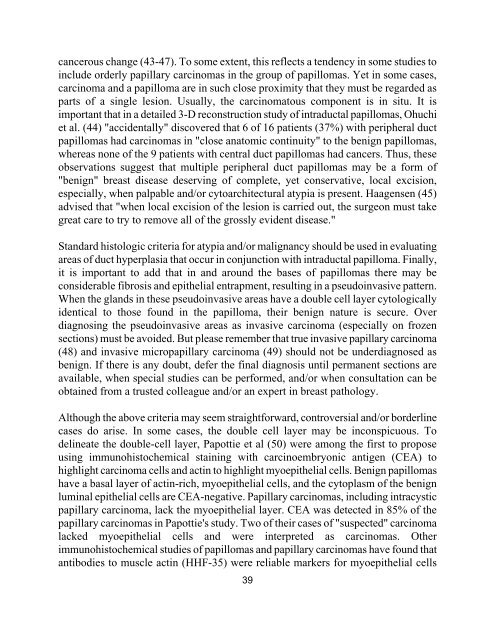33 Special Types of Invasive Breast Carcinoma: Diagnostic Criteria ...
33 Special Types of Invasive Breast Carcinoma: Diagnostic Criteria ...
33 Special Types of Invasive Breast Carcinoma: Diagnostic Criteria ...
Create successful ePaper yourself
Turn your PDF publications into a flip-book with our unique Google optimized e-Paper software.
cancerous change (43-47). To some extent, this reflects a tendency in some studies to<br />
include orderly papillary carcinomas in the group <strong>of</strong> papillomas. Yet in some cases,<br />
carcinoma and a papilloma are in such close proximity that they must be regarded as<br />
parts <strong>of</strong> a single lesion. Usually, the carcinomatous component is in situ. It is<br />
important that in a detailed 3-D reconstruction study <strong>of</strong> intraductal papillomas, Ohuchi<br />
et al. (44) "accidentally" discovered that 6 <strong>of</strong> 16 patients (37%) with peripheral duct<br />
papillomas had carcinomas in "close anatomic continuity" to the benign papillomas,<br />
whereas none <strong>of</strong> the 9 patients with central duct papillomas had cancers. Thus, these<br />
observations suggest that multiple peripheral duct papillomas may be a form <strong>of</strong><br />
"benign" breast disease deserving <strong>of</strong> complete, yet conservative, local excision,<br />
especially, when palpable and/or cytoarchitectural atypia is present. Haagensen (45)<br />
advised that "when local excision <strong>of</strong> the lesion is carried out, the surgeon must take<br />
great care to try to remove all <strong>of</strong> the grossly evident disease."<br />
Standard histologic criteria for atypia and/or malignancy should be used in evaluating<br />
areas <strong>of</strong> duct hyperplasia that occur in conjunction with intraductal papilloma. Finally,<br />
it is important to add that in and around the bases <strong>of</strong> papillomas there may be<br />
considerable fibrosis and epithelial entrapment, resulting in a pseudoinvasive pattern.<br />
When the glands in these pseudoinvasive areas have a double cell layer cytologically<br />
identical to those found in the papilloma, their benign nature is secure. Over<br />
diagnosing the pseudoinvasive areas as invasive carcinoma (especially on frozen<br />
sections) must be avoided. But please remember that true invasive papillary carcinoma<br />
(48) and invasive micropapillary carcinoma (49) should not be underdiagnosed as<br />
benign. If there is any doubt, defer the final diagnosis until permanent sections are<br />
available, when special studies can be performed, and/or when consultation can be<br />
obtained from a trusted colleague and/or an expert in breast pathology.<br />
Although the above criteria may seem straightforward, controversial and/or borderline<br />
cases do arise. In some cases, the double cell layer may be inconspicuous. To<br />
delineate the double-cell layer, Papottie et al (50) were among the first to propose<br />
using immunohistochemical staining with carcinoembryonic antigen (CEA) to<br />
highlight carcinoma cells and actin to highlight myoepithelial cells. Benign papillomas<br />
have a basal layer <strong>of</strong> actin-rich, myoepithelial cells, and the cytoplasm <strong>of</strong> the benign<br />
luminal epithelial cells are CEA-negative. Papillary carcinomas, including intracystic<br />
papillary carcinoma, lack the myoepithelial layer. CEA was detected in 85% <strong>of</strong> the<br />
papillary carcinomas in Papottie's study. Two <strong>of</strong> their cases <strong>of</strong> "suspected" carcinoma<br />
lacked myoepithelial cells and were interpreted as carcinomas. Other<br />
immunohistochemical studies <strong>of</strong> papillomas and papillary carcinomas have found that<br />
antibodies to muscle actin (HHF-35) were reliable markers for myoepithelial cells<br />
39


